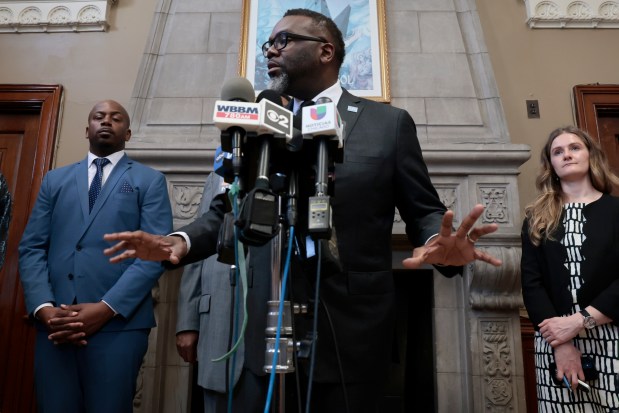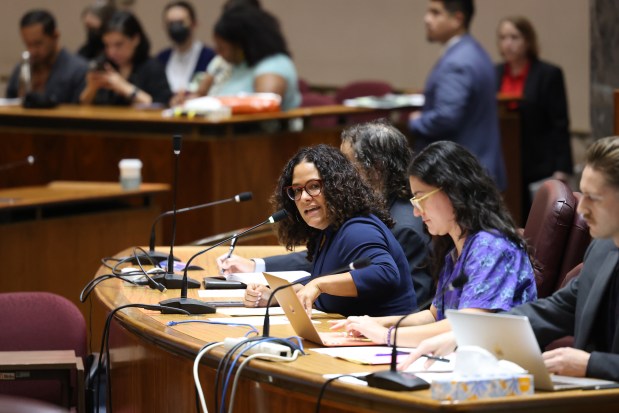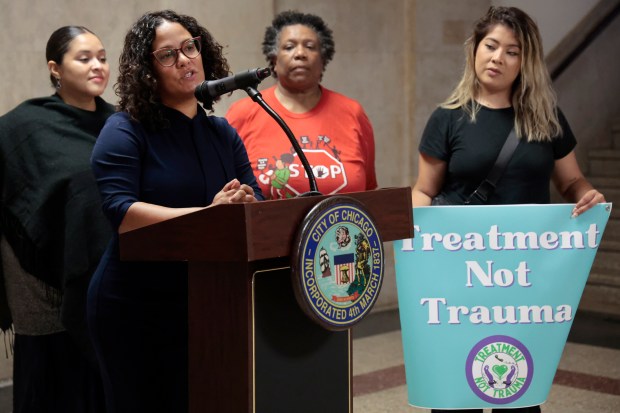Belmont Cragin residents were filing into the cafeteria at Prieto Math and Science Academy last month to weigh in on Mayor Brandon Johnson’s signature plan to overhaul Chicago’s mental health system when they got unexpected evidence that the bold, still largely theoretical plan remains a focus at City Hall.
Into the school walked Johnson, an unannounced guest at the community forum, surrounded by a flock of leading administration officials.
“It’s one of our top priorities,” he told attendees, before talking about his older brother, Leon, who dealt with untreated mental illness and died addicted and unhoused. “Our ultimate goal, our primary goal, is that we provide mental health services without barriers. That when, where and however individuals and families need these services, the city of Chicago shows up.”
Despite the mayor’s words, however, the actual progress on his campaign promise to install the so-called Treatment Not Trauma plan remains difficult for Chicagoans to see. The City Council tasked a working group with answering many of the toughest implementation questions: where to open facilities, what to ask for in the budget, how many people to hire and more. Beyond that, few changes have materialized.
But the path forward should soon become clearer: A year into Johnson’s first term, the working group’s report outlining the plan’s future will be published later this month. For the coalition of activists who have spent a decade pushing for the policy and dogging mayors to enact it, the city’s report should finally prove whether or not Johnson is truly offering a different path for mental health care in Chicago.
The people working to implement Treatment Not Trauma remain optimistic about the potentially sweeping policy’s future. But some of its proponents looking in from outside the bureaucratic process worry the long-awaited proposals are moving too slowly and will not live up to the bold vision championed by years of community organizing.
Johnson quickly passed an ordinance to launch the city’s working group once in office, but to move forward, the policy needs “active leadership” from City Hall, not “infinite working groups, infinite consensus buildings and no movement,” said Eric Reinhart, a public health, law and psychiatry anthropologist and physician who co-drafted the “white paper” report published by the activist coalition that pushed for the policy.
“I think it’s quite disappointing to all of us that a year into this administration, that even on the campaign stage held up Treatment Not Trauma as one of its core priorities, we still haven’t made any steps forward,” he said. “Everybody’s getting a working group, but where are we seeing implementation?”
But Reinhart’s white paper co-author, Arturo Carrillo, expressed optimism after the Prieto Academy event. A member of the working group preparing the policy’s path forward, Carrillo is also a social worker who directs violence prevention and health initiatives for the Brighton Park Neighborhood Council, part of the broad Treatment Not Trauma coalition.
“It’s almost like we are playing catch up,” Carrillo said. “This should have been started four years ago. Under the last administration. We were constantly being told no, we were constantly seeing barriers put up. Complete resistance to any input. Now we absolutely see the wheels of government moving.”
The plan took its first steps toward concrete action in November when Johnson’s 2024 budget included $15.9 million to double non-police emergency response and another $5.2 million to reopen two of the 14 city-run mental health centers closed by past mayors. Nearly six months later, the clinics have yet to reopen.
Johnson’s policy chief Umi Grigsby and Deputy Mayor of Community Safety Garien Gatewood defended the slow progress as proof the city is carefully gathering input across the city and “going at the pace of community.” So far, the city has hosted 15 public feedbacks centered on the plan, which remains on track to follow the timeline set by the City Council.
“This process has been very intentional,” Gatewood said. “We are trying to do things that folks have never done before. Instead of coming in and prescribing to folks, ‘This is what you need,’ we are building together in real time.”
Grigsby and Gatewood declined to share specifics about the city’s Treatment Not Trauma plan in an interview last week, citing the need to wait for the working group to first share its report with the City Council. But the two administration leaders helping to steer the fledgling policy hinted at its scope.
“Our goal is to expand mental health services. And so that means that we have to look at staffing, we have to look at career pipelines, we have to look at budgeting in the long term,” Grigsby said.
Johnson’s administration plans to add the first two clinics by the end of the year and expects more clinics after this year, Grigsby said.

The clinic reopenings are also a goal of the American Federation of State, County and Municipal Employees, a strong Johnson labor ally whose members lost jobs when Mayor Rahm Emanuel shuttered six city-run clinics in 2011.
The AFSCME International Union PAC contributed $100,000 to Johnson’s mayoral campaign last year, according to state campaign finance records. And AFSCME Illinois Council 31’s PAC contributed $56,750 to Johnson in 2018 during his successful run for Cook County commissioner.
Many activists claim city-run centers are a better option than the private, nonprofit clinics that serve many Chicagoans because the city clinics have more oversight, focus on outcomes over cost and have a more substantial community connection.
It is so far unclear where the clinics will reopen, though Johnson promised they will come “in neighborhoods with the highest unmet needs.” City leaders have also recently said they may expand mental health care by layering services into existing Chicago Department of Public Health clinics.
Johnson also intends to continue building out the Crisis Assistance Response and Engagement, or CARE, program piloted by former Mayor Lori Lightfoot, Gatewood said.
The program sends non-police first responders to 911 calls regarding mental health crises, substance use and homelessness issues, currently using a handful of teams operating in selected neighborhoods. Gatewood declined to say how common CARE responses could become across the city, but described expansion as a way to relieve pressure on overworked police.
“There are areas and spaces that police shouldn’t be responding to, right? We know that, they know that, and a lot of community members know that too,” he said.
The two leaders had little to say about a proposed third pillar of the Treatment Not Trauma plan: a new, expansive network of nonprofessional “community care workers” employed by the city to work in neighborhood-based teams.
The so-called care corps would mark a dramatic shift away from clinic-based mental health services. Its workers would be tasked with finding ways to meet smaller needs through daily outreach in a bid to prevent mental health crises before they occur.
The positions were not specifically discussed as a series of city leaders spoke at the Prieto Academy gathering, though speakers did reference a need for “extensive community outreach.”

And Gatewood and Grigsby shared few thoughts when asked about the role care workers would play in the policy’s implementation, but flagged the need to build mental health outreach worker training pipelines alongside city colleges and schools.
“It’s about growing and expanding not only the services, but the people who are able to provide those services,” Grigsby said.
If the city does not implement a large-scale care corps as a part of Treatment Not Trauma, it will fall short of the standards set forth by activists who started to push for the policy after Emanuel closed the clinics, Reinhart said.
The policy’s original vision was not “just creating a bunch of city-run mental health centers where people can see psychiatrists and therapists,” Reinhart said. Instead, it was to have a whole new model — one that uses traditional clinic-based care and the alternative emergency response aspect, but also relies heavily on care workers.
“Simply expanding the existing model, that’s not TNT. That’s something else, and it’s already failed,” he said. “My biggest concern is that pieces of the vision will be closed off and touted as TNT without the whole vision. But you need the whole thing for it to work.”
Ald. Rossana Rodriguez Sanchez, 33rd, the policy’s chief City Council proponent, tried unsuccessfully for years to move it forward under Lightfoot’s administration. The gradual process to “make it a reality” now allows for it to be “rooted in community,” she said.
“There is a lot of work to do,” Rodriguez Sanchez said. “What we are trying to do does not exist anywhere in the country.”
jsheridan@chicagotribune.com





